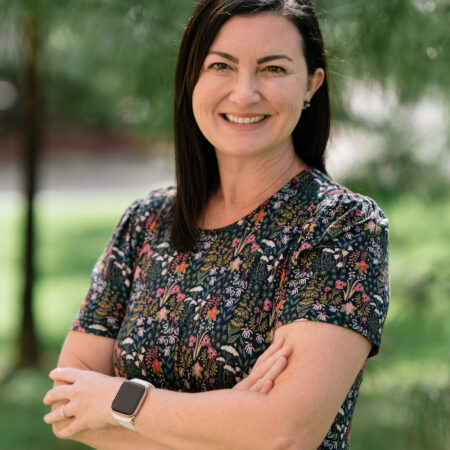
Kaitlin Lansford
Professor and Associate Dean for Research and Creative Activities
Dr. Kaitlin Lansford is Professor at Florida State University (FSU) in the School of Communication Science and Disorders and Associate Dean for Research and Creative Activities for CCI. She iis also the director of the Motor Speech Disorders Lab (MSDLab) at FSU. Lab members of the MSDLab conduct research on dysarthric speech perception and adaptation. Exploiting the relationship between the degraded acoustic signal and the nature of the listener’s challenge has the potential to be a powerful paradigm for studying intelligibility deficits in dysarthria because results may point directly toward intervention targets, as well as inform theory on the perception of degraded speech. Her current work focuses on perceptual training, which offers a promising avenue for improving intelligibility of people with dysarthria by offsetting the communicative burden from the patient onto their primary communication partners.
Education
- University of Arizona, B.S., 1999
- Arizona State University, M.S., 2004
- Arizona State University, Ph.D., 2012
Research Interests
Motor-Speech Disorders; Disordered and Degraded Speech Perception; Perceptual Learning; Childhood Apraxia of Speech
Teaching Interests
Motor speech disorders, research evaluation, neural bases of communication
Publications & Research
Select Publications
- Tetzloff, K.A., Fletcher, A.R., Lansford, K.L., Barrett, T.S., & Borrie, S.A. (2025). Bilingual perception of dysarthric speech. Journal of Speech, Language, and Hearing Research. 1-18. https://doi.org/10.1044/2025_JSLHR-25-00288
- Lansford, K. L., *Hirsch, M. E., Barrett, T. S., & Borrie, S. A. (2025). Cognitive predictors of perception and adaption to dysarthric speech in older adults. Journal of Speech, Language, and Hearing Research
- Borrie, S.A., Tetzloff, K.A., Barrett, T.S., & Lansford, K.L. (2024). Increasing motivation increases intelligibility benefits of perceptual training of dysarthric speech. American Journal of Speech-Language Pathology. https://doi.org/10.1044/2024_AJSLP-24-0019
- Borrie, S.A., *Hepworth, T.J., *Wynn, C., Barrett, T.S., Hustad, K.C., & Lansford, K.L. (2023). Perceptual learning of dysarthria in adolescence. Journal of Speech, Language and Hearing Research, 66(10), 3791-3803. https://doi.org/10.1044/2023_JSLHR-23-00231
- *Thompson, A., *Hirsch, M., Lansford, K.L., & Kim, Y. (2023). Vowel acoustics as predictors of speech intelligibility in dysarthria. Journal of Speech, Language and Hearing Research, 66(8S), 3100-3114. https://doi.org/10.1044/2022_JSLHR-22-00287
- Lansford, K.L., Barrett, T.S., & Borrie, S.A. (2023). Cognitive predictors of perception and adaptation to dysarthric speech in young adult listeners. Journal of Speech, Language, and Hearing Research, 66(1), 30-47. https://doi.org/10.1044/2022_JSLHR-22-0039
- Spencer, K., Amaral, J., & Lansford, K.L. (accepted). Perceptual subgroups in speakers with ataxic dysarthria: an auditory free-classification approach. Journal of Speech, Language and Hearing Research.
- *Hirsch, M., Thompson, A., Kim, Y., & Lansford, K.L. (2022). The reliability and validity of speech-language pathologists’ estimations of intelligibility in dysarthria. Brain Sciences, 12(8), 1011. https://doi.org/10.3390/brainsci12081011
- Borrie, S.A. & Lansford, K.L. (2021). A perceptual learning approach for dysarthria remediation: An updated review. Journal of Speech, Language and Hearing Research. 4(8), 3060-3073. https://doi.org/10.1044/2021_JSLHR-21-00012
- Borrie, S.A., Lansford, K.L., & Barrett, T.S. (2021). A Clinical Advantage: Experience informs recognition and adaptation to a novel talker with dysarthria. Journal of Speech, Language and Hearing Research. 64(5), 1503-1514. https://doi.org/10.1044/2021_JSLHR-20-00663
- *Hirsch, M., Lansford, K.L., Barrett, T.S., & Borrie, S.A. (2021). Generalized learning of dysarthric speech between male and female talkers. Journal of Speech, Language and Hearing Research, 64(2), 444-451. https://doi.org/10.1044/2020_JSLHR-20-00313
- Lansford, K.L., Borrie, S.A., Barrett, T.S., & Flechaus, C. (2020). When additional training isn’t enough: Further evidence that unpredictable speech inhibits adaptation. Journal of Speech, Language and Hearing Research, 63(6), 1700-1711. https://doi.org/10.1044/2020_JSLHR-19-00380
- Ingvalson, E. M., & Lansford, K. L. (2020). Older adults' perception of multiple speech types predicted by common cognitive factors. Acoustical Science and Technology, 41(1), 390- 393.
- Lansford, K.L., Borrie, S.A., & Barrett, T.S. (2019). Regularity matters: Unpredictable speech degradation inhibits adaptation to dysarthric speech. Journal of Speech, Language and Hearing Research, 62(12). https://doi.org/10.1044/2019_JSLHR-19-00055
- Utianski, R. L., Sandoval, S., Berisha, V., Lansford, K. L., & Liss, J. M. (2019). The effects of speech compression algorithms on the intelligibility of two individuals with dysarthric speech. American Journal of Speech-Language Pathology, 28, 195–203. https://doi.org/10.1044/2018_AJSLP-18-0081
- Lansford, K.L., Luhrsen, S., Ingvalson, E., & Borrie, S.A. (2018). Effects of familiarization on intelligibility of dysarthric speech in older adults with and without hearing loss. American Journal of Speech Language Pathology, 27, 91-98. doi:10.1044/2017_AJSLP-17-0090
- Borrie, S.A., Lansford, K.L., and Barrett, T.S. (2018). Understanding dysrhythmic speech: When rhythm does not matter and learning does not happen. Journal of the Acoustical Society of America, 143(5): EL379–EL385. https://doi.org/10.1121/1.5037620
*Publications marked with an asterisk are based on research conducted by graduate students under my sole or joint supervision.
Grants & Awards
Extramural Awards
- Lansford, K.L. (Role: co-PI; S. Borrie). “Listener training for improved intelligibility of people with Parkinson’s disease.” NIH/NIDCD, 1R01DC020930-02. Grant period: July 2024 – June 2029. Amount $2.2 million.
- Lansford, K.L. (Role: PI) “Speaker and listener strategies to improve intelligibility in Parkinson’s disease.” Parkinson's Foundation Impact Award, PF-IMP-1045942; Grant period: July 2023–July 2025. Amount $150,000
- Lansford, K.L. (Role: co-PI; S. Borrie). “Perceptual training for improved intelligibility of dysarthric speech.” NIH/NIDCD, R21DC018867, Grant period 7/20-6/23. Amount $275,000
- Lansford, K.L. (Principal Investigator). "Use of crowdsourcing to assess the ecological validity of perceptual learning paradigms in dysarthria." ASHFoundation, New Century Scholars Research Grant. Awarded: November, 2014. Amount $10,000
- Lansford, K.L. (Principal Investigator). “Perceptual similarity in dysarthria and the implications for learning.” ASHFoundation, Speech Science Research Grant supported by the Dennis Klatt Memorial Fund. Awarded: November, 2012. Amount: $5,000
- Lansford, K.L. (Principal Investigator; Sponsored by J. Liss). “Framework for a perceptual taxonomy of dysarthric speech.” National Institute of Health, National Institute on Deafness & other Communication Disorders 1F31 DC010093. Award period: May 1, 2011-April 30, 2012. Amount: $30,690.
Intramural Awards
- Lansford, K.L. (PI). “Listener-targeted training for improved understanding of dysarthric speech.” Committee on Faculty Research Support, Council on Research & Creativity, Florida State University. Project cycle: 2022-2023. Amount: $20,000.
- Lansford, K.L. (Principal Investigator). “Perceptual consequences of similar-sounding speakers with dysarthria.” Committee on Faculty Research Support, Council on Research & Creativity, Florida State University. Project duration: May 2014-August 2014. Amount: $14,000.
- Lansford, K.L. (Principal Investigator). “Perceptual similarity in dysarthria.” First-Year Assistant Professor award, Council on Research & Creativity, Florida State University. Project duration: May 2013-August 2013. Amount: $20,000.
Expertnet Profile
